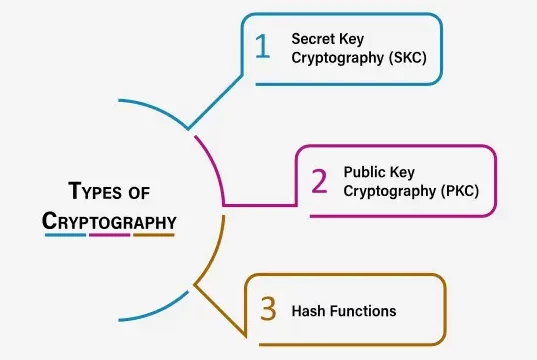What is Cryptography? Meaning, Types and Techniques
Table of Contents

As data is now the world’s most valuable asset, safeguarding it has never been more important. From financial details and transactions to state security communications, encryption is the intangible layer of protection that secures the digital space. Despite its increasing significance, however, cryptography’s meaning and its applications in real life are ill-understood by most.
For career changers seeking high-growth cybersecurity, software engineering, or blockchain careers, a foundation in cryptography basics can be the key to unlocking powerful new prospects. Whether you’re looking to become an expert in information security or merely remain competitive in today’s changing tech environment, cryptography is an important—and frequently critical—skill.
Why Cryptography Matters in Today’s Digital-First Careers
Have you ever wondered how your bank details stay secure during online transactions or how companies protect sensitive data from cyber threats? In an increasingly digital world, data protection isn’t just an IT concern—it’s a business imperative. As the demand for cybersecurity experts rises, understanding cryptography’s meaning becomes not only relevant but essential for professionals across sectors.
Professionals today across tech, finance, healthcare, and education are proactively upskilling to remain valuable. As new technologies remake old jobs, cryptography is becoming an essential subject for individuals who want to advance in cybersecurity, data science, and software development.
Whether you are looking for a career change, wanting to specialize in IT, or just wanting to enhance your cryptography basics, this blog will take you through what cryptography is, cryptography types, and major techniques dominating the digital security world today.
Cryptography Meaning and Modern Relevance

*techtarget.com
At its core, cryptography’s meaning is that it is a science of securing information. It involves converting data into a format that only intended recipients can understand, preventing unauthorized access. In practical terms, cryptography basics ensure confidentiality, data integrity, authentication, and non-repudiation.
Cryptography meaning: The method of protecting information by transforming it into an unreadable format using mathematical algorithms. Only those with a “key” can decode and access the original message.
From securing emails to enabling blockchain transactions and ensuring regulatory compliance in data-sensitive industries, cryptography is everywhere. As digital threats grow, so does the need for skilled professionals well-versed in cryptography.
Types and Techniques of Cryptography

*sprintzeal.com
Now let’s understand the fundamental types and techniques of cryptography you should know. This section is designed in listicle format for clarity, with industry perspective in support.
1. Types of Cryptography
Knowing the various cryptography types is important for choosing the appropriate method to protect information based on given requirements and limitations. Each type has specific strengths and weaknesses, so it is imperative for experts to understand their uses and limitations. This is the basis for establishing effective cybersecurity measures in any sector.
| Cryptography Types | Description | Common Use Cases | Pros | Cons |
|---|---|---|---|---|
| Symmetric Key Cryptography | Uses the same key for encryption and decryption. | File storage, database encryption | Fast and efficient | Key distribution is complex |
| Asymmetric Key Cryptography | Uses a public key to encrypt and a private key to decrypt. | Email encryption, digital signatures | High security | Slower performance |
| Hash Functions | Irreversible transformation of data into a fixed-size string (hash). | Password verification, data integrity | Fast, no key required | Cannot retrieve original data |
| Quantum Cryptography | Uses principles of quantum mechanics for secure communication. | Research and defense systems | Ultra-secure | Still experimental |
2. Techniques Used in Cryptography
Knowledge of cryptography’s meaning and methods facilitates the understanding of its use in industries. Listed below are some of the most important methods commonly used in current systems:
- Encryption and Decryption: Converts plaintext to ciphertext and vice versa using algorithms and keys.
- Digital Signatures: Authenticates the sender’s authenticity and the integrity of digital documents or messages.
- Key Exchange Protocols: Securely shares cryptographic keys between users—critical in key management in cryptography.
- Message Authentication Codes (MAC): Ensures the message has not been tampered with.
- Zero-Knowledge Proofs: Allows data verification without revealing actual data—vital for privacy-preserving systems.
3. Key Management in Cryptography
Effective key management in cryptography is critical because even the strongest encryption algorithms can be compromised if keys are mishandled. Proper generation, distribution, storage, and rotation of keys ensure the overall security of cryptographic systems. Professionals skilled in key management are vital to maintaining trust in digital communications and safeguarding sensitive data across industries.
| Key Management Aspect | Description | Best Practices |
|---|---|---|
| Key Generation | Secure creation of cryptographic keys | Use of hardware security modules (HSMs) |
| Key Storage | Secure storage of keys | Encrypted storage, isolated environments |
| Key Distribution | Sharing keys between systems or users | Use key exchange protocols (e.g., Diffie-Hellman) |
| Key Rotation | Replacing old keys periodically | Automate key rotation policies |
| Key Revocation | Disabling compromised or expired keys | Maintain key lifecycle policies |
4. Cryptography Use Cases by Industry
Cryptography plays a foundational role across multiple industries, enabling secure digital operations, compliance with data privacy regulations, and protection against cyber threats. As businesses increasingly rely on digital infrastructure, the demand for professionals with cryptographic expertise is expanding rapidly. Understanding how cryptography basics are applied in different sectors helps you identify high-potential career paths aligned with your background or interests.
| Industry | Use Cases | Growth Outlook (2024–2028) |
|---|---|---|
| Finance (BFSI) | Digital transactions, quantum‑safe encryption, fraud prevention | BFSI leads with >28% of quantum‑safe crypto market share (Dataintelo) |
| Healthcare | EHR protection, HIPAA compliance, telemedicine security | Healthcare holds ~26.5% share in quantum cryptography market (IMARC Group) |
| Government & Defense | Secure comms, classified data protection, PQC deployment | Dominates post‑quantum cryptography adoption (GlobeNewswire, Growth Market Reports) |
| IT & Telecom | Network encryption, 5G/edge security, secure cloud pipelines | Rapid adoption across cryptographic evaluation markets (Dataintelo, MarkWide Research) |
| Retail & E‑commerce | Payment gateways, customer data encryption | Growing cryptographic investment for PCI-DSS and data protection (Verified Market Reports, Dataintelo) |
5. Careers in Cryptography
For professionals exploring cryptography meaning and prominent roles with average annual salaries:
| Job Role | Average Salary in India (INR) | Skill Requirements |
|---|---|---|
| Cryptographer | ₹6 L – ₹15 L | Algorithms, C/C++, Python, cryptographic theory |
| Security Architect | ₹20–30 LPA | Network security, cryptographic systems |
| Information Security Analyst | ₹6–10 LPA | SIEM tools, encryption, risk assessment |
| Blockchain Developer | ₹8–15 LPA | Cryptography, smart contracts, Ethereum |
| Penetration Tester | ₹7–12 LPA | Ethical hacking, encryption protocols |
Data Source: naukri.com
How Jaro Education Helps You Upskill in Cryptography
Understanding cryptography basics is just the start. To build a career in this high-demand field, you need structured learning, industry-aligned projects, and expert mentorship.
Jaro Education: Your Pathway to Figuring out Cryptography Meaning with Excellence
Jaro Education partners with India’s top institutes like IITs, IIMs, and top global universities to offer certification and executive programs designed for working professionals.
Featured Program:
Professional Certificate Programme in Blockchain and Financial Technology
By IIM Kozhikode
Program Highlights:
| Feature | Details |
| Duration | 12 Months |
| Format | Online Live Sessions + Self-paced modules |
| Ideal For | IT professionals, engineers, security analysts |
| Key Skills Covered | Encryption, key management, cryptographic algorithms |
| Faculty | IIT faculty & industry experts |
Note: Jaro Education acts as a service and counseling partner. Degree and certificate issuance is managed directly by the partner institute.
Jaro’s Unique Offerings:
- Personalized Counseling: Explore the best-fit course based on your career goals.
- Market-Aligned Programs: Designed in collaboration with top universities to ensure industry relevance.
- Jaro Connect: A dedicated value-added platform offering networking, career support, and alumni interactions.
Future-Proof Your Career with the Right Learning Path
In a world driven by data, securing that data is non-negotiable. Understanding cryptography meaning, the various cryptography types, and how techniques like key management work can give you a competitive edge in today’s job market. Whether you’re planning a career transition, aiming to specialize in cybersecurity, or simply upskilling to future-proof your role, the time to act is now.
With expert-backed programs, real-world curriculum, and personalized guidance, Jaro Education is your trusted partner in navigating this transformative journey. Let knowledge be your shield in the digital age—empower your career through structured learning and industry-relevant skills.
Frequently Asked Questions
What kind of support does Jaro provide during the course?
Jaro offers dedicated learner support, live session access, personalized career counseling, and value-added services through Jaro Connect. You also benefit from structured program delivery by expert faculty.
Can I apply if I am working full-time?
Yes. All programs suit working professionals, with weekend live classes and self-paced modules—ideal, whether you’re learning cryptography’s meaning or cybersecurity related topics alongside your job.
How is this program different from a regular online course?
Delivered with premier institutes like IITs and IIMs, Jaro’s courses combine academic rigor with industry relevance. For example, in cryptography, you go beyond cryptography’s meaning to applying it in real-world encryption and data security.
Will this program help me transition into a new industry?
While no program guarantees placement, skills in cryptography and cybersecurity—starting from cryptography’s meaning to advanced applications—boost employability in sectors like finance, IT, and defense.
What prior knowledge or background do I need to enroll in a cryptography program?
Most programs require a basic understanding of computer science or IT fundamentals. Some familiarity with programming and mathematics can be helpful but not always mandatory, as foundational concepts are often covered in the curriculum.
How can learners stay updated with the latest cryptography trends and technologies?
To deepen their understanding of cryptography’s meaning and its real-world applications, learners should stay informed through research articles, hands-on practice with cryptographic tools, tech forums, and advanced online courses. This helps them keep pace with evolving techniques and threats in the digital security landscape.


















